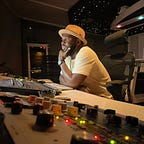A couple of months ago, I was helping a friend mix a record. As the final step, we needed to do some volume adjustments so that the song would sound more like the other songs on her EP. At first, my friend wasn’t sure what I meant by this. She said she thought all of her songs sounded just fine — which they did! But then she listened to them side by side and realized that one of her songs was a couple of decibels louder than the others at its loudest moments. Once she started turning down her drums and boosting her bass, it became clear why volume adjustments were necessary: it made all of the songs feel more cohesive as an album. Plus, it made the overall listening experience better for anyone who put on their headphones and pressed Play.
A volume adjustment was inevitable.
With the advent of loudness, volume has become a relative quality. You might have heard some music that sounds soft and quiet, while another recording feels much louder.
Does this mean we’re going to be stuck with all of our music sounding like it’s been run through a blender? Will every song now be at max volume?
No! The fact is, there are some things you can do to keep your master from being so loud, like using a plugin like Youlean’s Loudness Meter. This plugin helps you find the true perceived loudness of your audio and prepares it for streaming services.
Streaming services design a faux-dynamic range.
Streaming services — including Spotify, Apple Music, and Tidal — limit the dynamic range of music. This means that a song’s quietest parts are played back at a lower level than its loudest parts. In other words, it sounds louder even though it isn’t necessarily any louder! The result of this is called Loudness War Syndrome (LWS), and it’s not good for anyone involved: not the listeners or artists who make music with dynamic range; nor even streaming services themselves. As we’ll discuss later on in this article, LWS can negatively affect your listening experience by making your favorite songs sound overprocessed or distorted when they’re being played back through different devices like earbuds or Bluetooth speakers.
Ears are at the center of the controversy.
The battle over loudness has been raging for decades, and it’s not going to be resolved any time soon. But one thing is certain: ears are at the center of this controversy. We need a way to measure how loud something is, but we also need to know how it will affect our hearing.
So why don’t we use volume? Volume is just a measure of how much air goes through your speakers during playback — it doesn’t tell you anything about the damage that might be done to your ears. And because humans hear differently from each other (due primarily to differences in ear shape), one person’s idea of “too loud” can differ greatly from another person’s idea.
Enter LUFS: loudness units relative to full scale (LUF). This standard was developed by audio engineers so they could talk about how loud something was without worrying about individual listeners’ sensitivities or preferences for louder music versus softer music. Nowadays, there are several different LUFS standards used across industries and professions; what matters isn’t so much which standard you’re working with as long as everyone on your team knows which one they’re using and sticks with it throughout their projects!
The podcasting revolution, too, is to blame.
Podcasts are a big part of the problem. Unlike radio, podcasts aren’t restricted by the same rules as music. That means they can go louder than other media — and often do. Podcasts like “The Joe Rogan Experience” and “S-Town” make liberal use of dynamic compression to push their loudness levels into the red zone, especially during moments of high excitement or anger. (The latter is particularly egregious.) It’s hard to imagine anyone listening to these shows on earbuds or headphones — the volume just wouldn’t be enough to compete with all that screaming!
We need loudness units because people want their music louder.
The people want their music loud.
They always have, and they always will. They want their music louder than the next person’s, they want it louder than they can get it by themselves on a portable device like a smartphone or MP3 player. They always have done this and will continue to do so until we find a way to make all of our songs sound as good as a vinyl record played in mono mode on an old turntable with no needle (an analogue system).
